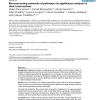5 search results - page 1 / 1 » Controlling the false discovery rate in modeling brain funct... |
ICASSP
2008
IEEE
13 years 11 months ago
2008
IEEE
Graphical models of brain functional connectivity have matured from con rming a priori hypotheses to an exploratory tool for discovering unknown connectivity. However, exploratory...
BMCBI
2010
13 years 4 months ago
2010
Background: High-throughput technologies have led to a new era of proteomics. Although protein microarray experiments are becoming more common place there are a variety of experim...
BMCBI
2004
13 years 4 months ago
2004
Background: Two or more factor mixed factorial experiments are becoming increasingly common in microarray data analysis. In this case study, the two factors are presence (Patients...
BMCBI
2010
13 years 4 months ago
2010
Background: Novel strategies are required in order to handle the huge amount of data produced by microarray technologies. To infer gene regulatory networks, the first step is to f...
BMCBI
2008
13 years 4 months ago
2008
Background: Significance analysis at single gene level may suffer from the limited number of samples and experimental noise that can severely limit the power of the chosen statist...



